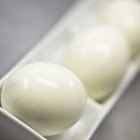
Eggs are one of the world's most versatile foods. The success of cookies, quick breads, cakes, ice cream and many other recipes all depends on eggs. However, eggs are most commonly eaten on their own and are adaptable to many simple cooking methods. The differences between a fried and poached egg lie in how they are cooked.
Frying Eggs
Fried eggs are easy and quick. Start with a non-stick or well-seasoned cast iron skillet, as eggs are prone to sticking to the pan. Heat a couple teaspoons of butter, margarine, oil or bacon drippings in the skillet over medium heat. When the frying liquid starts bubbling, crack an egg and gently place it into the pan. In two to three minutes, the white will be set and the bottom of the egg will be light brown.
Sunny Side Up and Over-Easy
If you remove the fried egg immediately, it will be sunny side up, with a mostly raw yolk. To cook the yolk a bit more, baste it with the pan drippings or cover the pan, remove it from the heat and let it set for a minute or two. To make eggs over-easy, turn the egg after the bottom browns and cook for another minute or so. For over-medium or over-hard eggs, cook them a few minutes longer on the second side.
Basic Poaching Method
Poached eggs take a notoriously high skill level to prepare. There are many suggested methods but two are typically preferred. For the first method, break an egg into a small cup or ramekin and add a dash of vinegar. The vinegar won't flavor the egg but it helps the white form around the yolk during poaching. Pour two to three inches of water into a saucepan, add a pinch of salt and slowly bring the water to a full simmer. Create a whirlpool or vortex in the center of the pan with a whisk and while the water is in motion, slowly and carefully pour the egg into the eye of the whirlpool. Immediately reduce the heat to low and cook the egg undisturbed for two to three minutes for a runny yolk and four to five minutes for a more solid yolk. Use a spider or slotted spoon to gently remove the egg and season with salt and pepper.
Alternative Poaching Technique
Another method involves adding vinegar to the poaching liquid rather than the egg. Proceed as in the first method but after the egg has simmered for about 30 seconds, turn off the heat and cover for two to five minutes until the yolks are set to your preference. Season to taste with salt and pepper.
Related Articles
How to Fry an Egg Without It Turning ...

How to Cook Eggs Sunny Side Up Without ...
How to Make Eggs Over Easy
How to Make an Overeasy Egg

Can You Poach an Egg Without Vinegar?
How to Cook Over-Easy Eggs in a ...
Simple and Delicious Egg Salad Recipe

How to Cook a Hard Boiled Egg With a ...

How to Make Salted Egg
How to Cook Scrambled Eggs Using a Slow ...

Using a Convection Oven to Cook ...

How to Cook Scrambled Eggs on a Griddle

Why Do Boiled Eggs Smell?

How to Cook Eggs Without Sticking
How to Cook Fried Flounder Fillets

How to Cook Haddock Roe

How Can I Tell If an Egg Is Hard-Boiled ...

How to Make Quick Easy Egg Salad
How do I Keep Scrambled Eggs From ...

How to Straighten Shrimp for Tempura
References
Writer Bio
Cassie Damewood has been a writer and editor since 1985. She writes about food and cooking for various websites, including My Great Recipes, and serves as the copy editor for "Food Loves Beer" magazine. Damewood completed a Bachelor of Arts in English with an emphasis in creative writing at Miami University.
Photo Credits
Jupiterimages/Photos.com/Getty Images